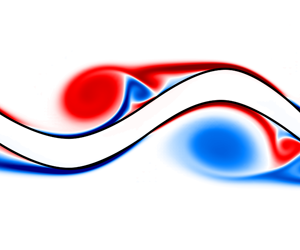Crossref Citations
This article has been cited by the following publications. This list is generated based on data provided by
Crossref.
Della Pia, Alessandro
Chiatto, Matteo
and
de Luca, Luigi
2020.
Global eigenmodes of thin liquid sheets by means of Volume-of-Fluid simulations.
Physics of Fluids,
Vol. 32,
Issue. 8,
Broumand, M.
Asgarian, A.
Bussmann, M.
Chattopadhyay, K.
and
Thomson, M. J.
2021.
Spatio-temporal dynamics and disintegration of a fan liquid sheet.
Physics of Fluids,
Vol. 33,
Issue. 11,
Della Pia, Alessandro
Colanera, Antonio
Chiatto, Matteo
and
de Luca, Luigi
2021.
Energy insights into the unsteady dynamics of a viscous gravitational liquid sheet.
Physics of Fluids,
Vol. 33,
Issue. 9,
Fiderek, Paweł
Kucharski, Jacek
and
Wajman, Radosław
2021.
Fuzzy Regulator for Two-Phase Gas–Liquid Pipe Flows Control.
Applied Sciences,
Vol. 12,
Issue. 1,
p.
399.
Schmidt, Simon
Tammisola, Outi
Lesshafft, Lutz
and
Oberleithner, Kilian
2021.
Global stability and nonlinear dynamics of wake flows with a two-fluid interface.
Journal of Fluid Mechanics,
Vol. 915,
Issue. ,
Tang, Jun
Zhang, Shengyuan
and
Wu, Huiying
2021.
Multiphase flow simulation with three-dimensional weighted-orthogonal multiple-relaxation-time pseudopotential lattice Boltzmann model.
Physics of Fluids,
Vol. 33,
Issue. 12,
Della Pia, Alessandro
Chiatto, Matteo
and
de Luca, Luigi
2021.
Receptivity to forcing disturbances in subcritical liquid sheet flows.
Physics of Fluids,
Vol. 33,
Issue. 3,
Colanera, Antonio
Della Pia, Alessandro
Chiatto, Matteo
de Luca, Luigi
and
Grasso, Francesco
2021.
Modal decomposition analysis of unsteady viscous liquid sheet flows.
Physics of Fluids,
Vol. 33,
Issue. 9,
Liu, An
Sun, Dongliang
Yu, Bo
Wei, Jinjia
and
Cao, Zhizhu
2021.
An adaptive coupled volume-of-fluid and level set method based on unstructured grids.
Physics of Fluids,
Vol. 33,
Issue. 1,
Chiatto, Matteo
and
Della Pia, Alessandro
2022.
Natural frequency discontinuity of vertical liquid sheet flows at transcritical threshold.
Journal of Fluid Mechanics,
Vol. 945,
Issue. ,
Della Pia, Alessandro
Colanera, Antonio
and
Chiatto, Matteo
2022.
Surface tension-induced instability in spatially developing subcritical liquid curtains.
Physics of Fluids,
Vol. 34,
Issue. 4,
Colanera, Antonio
Della Pia, Alessandro
and
Chiatto, Matteo
2022.
Data-driven global stability of vertical planar liquid jets by dynamic mode decomposition on random perturbations.
Physics of Fluids,
Vol. 34,
Issue. 12,
Zhou, Chenglin
Zou, Jianfeng
and
Zhang, Yang
2022.
Effect of Streamwise Perturbation Frequency on Formation Mechanism of Ligament and Droplet in Liquid Circular Jet.
Aerospace,
Vol. 9,
Issue. 4,
p.
191.
Bodhanwalla, Hormuzd
Anghan, Chetankumar
and
Banerjee, Jyotirmay
2022.
The effect of one-sided confinement on nappe oscillations in free falling liquid sheet.
Physics of Fluids,
Vol. 34,
Issue. 12,
Acquaviva, Maria Rosaria
Della Pia, Alessandro
Colanera, Antonio
Chiatto, Matteo
and
de Luca, Luigi
2023.
Numerical investigation of hole propagation in a three-dimensional liquid curtain.
Della Pia, Alessandro
Antoniades, Michael G.
Ioannidis, Eleni S.
Wejko, Zoe A.
Barlow, Nathaniel S.
Chiatto, Matteo
Weinstein, Steven J.
and
de Luca, Luigi
2023.
On the shapes of liquid curtains flowing from a non-vertical slot.
Journal of Fluid Mechanics,
Vol. 974,
Issue. ,
Acquaviva, Maria Rosaria
Della Pia, Alessandro
Chiatto, Matteo
and
de Luca, Luigi
2023.
Hole-driven dynamics of a three-dimensional gravitational liquid curtain.
Journal of Fluid Mechanics,
Vol. 968,
Issue. ,
Ananth, Mohan
and
Trujillo, Mario F.
2023.
Breakup of planar liquid sheets injected at high speed in a quiescent gas environment.
Journal of Fluid Mechanics,
Vol. 975,
Issue. ,
Della Pia, Alessandro
Chiatto, Matteo
and
de Luca, Luigi
2024.
Varicose dynamics of liquid curtain: Linear analysis and volume-of-fluid simulations.
Physical Review Fluids,
Vol. 9,
Issue. 8,
Lin, Kai
Zhan, Jie-min
Li, Yi-hua
Hu, Wen-qing
and
Luo, Ying-ying
2024.
Numerical simulation of integrated lacquer curtain with filing angle at curtain coater.
AIP Advances,
Vol. 14,
Issue. 11,


